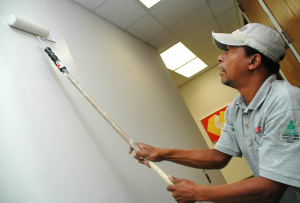NC State’s zero VOC paint swap trims costs, improves buildings

Flashback five years and paint being brushed and rolled on campus walls could be smelled before it was seen. The odor, created by emissions of volatile organic compounds (VOCs), was the hallmark of painting for decades until the recent evolution of low VOC and zero VOC paints, which are now the wall paint of choice for NC State.
“We switched to low VOC paint about five years ago,” said Bud Brannock, who has led the painters in NC State’s Repair and Renovation since 1999. “About two years ago when we found out we could get zero VOC paint at a lower price, we started doing that.”
In addition to trimming paint cost by 24 percent, zero VOC paint has also rolled on health benefits while reducing environmental air quality impacts of paint. According to the Environmental Protection Agency, VOCs – which can be 10 times stronger indoors than outdoors – have been related to health effects such as eye irritation and headaches, as well as other long-term conditions.

“Our campus customers have noticed [the reduction in odor from painting],” Brannock said. “They’ve made comments that they didn’t even know we were in the room.”
Beyond paint selection, the university’s dozen or so painters also use a special cleaning process that collects excess paint from brushes and rollers, solidifying it so that rinsing paint from these tools doesn’t clog drain pipes or contaminate water. They also keep and reuse extra paint and paint buckets when possible and consolidate driving across campus to save fuel.
So, next time you walk into a freshly-painted campus building and can’t smell the difference, that’s another example of sustainability at NC State in action – saving money, improving health and reducing environmental impacts.
- Categories: